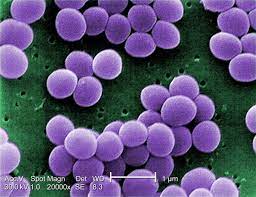
‘Staphylococcus not only sexually transmitted, can be acquired in hospital’
The National Coordinator, National Tuberculosis, Leprosy and Buruli Ulcer Control Programme, Dr. Chukwuma Anyaike, has said that people can get infected with staphylococcus aureus, a bacteria that can cause infection in humans without indulging in sexual acts.
The public health physician said although staphylococcus is sometimes misdiagnosed and also found on human skin, it can cause infection when it gets to the wrong place, especially in the private part.
According to him, there is a lot of misunderstanding surrounding the transmission of Staphylococcus.
He noted that some physicians say staphylococcus cannot be transmitted sexually, while some people believe it is an infection that is only associated with the private parts.
Anyaike, however, said people can get staphylococcus in the hospital through contaminated objects, adding that everybody is at risk of the disease.
The NTBLCP boss urged people to improve their hygiene and avoid multiple sex partners, warning that sometimes, people get infected with staphylococcus without knowing the source.
He said, “A lot of things can be sexually transmitted. When an organism is in the wrong place, it can be sexually transmitted.
“When you carry an organism into another place that is not supposed to be through sexual acts, it becomes sexually transmitted.
“So, staphylococcus can be sexually transmitted. It is not a normal organism in the vagina. You can see it on the skin. It is also a normal contaminant in the laboratory. Even during foreplay, staphylococcus can be introduced into the vagina. So, your hygiene must be high and you must be decent.
“Ordinarily, staphylococcus is not supposed to be found in the vagina of a woman and the urethra of a man because it is in the wrong place and if it is in the wrong place, it can come up with itching, and a burning sensation.”
The United States Centres for Disease Control and Prevention says staphylococcus aureus is a germ found on people’s skin.
CDC states that staphylococcus can cause serious infections if it gets into the blood and can lead to sepsis or death.
“People are at higher risk for staph infection when they have surgery or stay in healthcare facilities, have medical devices in their body, inject drugs, or when they come in close contact with someone who has staph”, the CDC added.
Speaking further, Anyaike noted that sometimes, staphylococcus comes as a contaminant in laboratory procedures.
“Staphylococcus can be found on normal skin, sometimes, that is why it comes as a contaminant”, he added.
The physician stated that staphylococcus could be treated and cured if the person diagnosed with the infection takes appropriate treatment.
Also, the national coordinator noted, “If an infection is caused by staphylococcus when it is widely cultured, it can be treated and cured by appropriate antibiotics after going through the sensitivity test.
“And because the organism is stubborn, sometimes, it changes its mutation, which is why it has become resistant to common antibiotics.
“When you have staphylococcus, once you treat yourself, you must treat your partner.”
He counselled those diagnosed with the infection to adhere to their medications as recommended by a physician to avoid the organism becoming resistant to drugs.
The Association for Professionals in Infection Control and Epidemiology says staphylococcus is a type of bacteria found on human skin, in the nose, armpit, groin, and other areas.
According to the association, staphylococcus is the leading cause of skin and soft tissue infections, such as abscesses, boils, furuncles, and cellulitis (red, swollen, painful, warm skin).
“Staphylococcus aureus germs can also cause more serious infections, such as pneumonia, bloodstream infections, endocarditis (infection of the inner lining of the heart chambers and heart valves), and bone and joint infections.
“It is spread by touching infected blood or body fluids, most often by contaminated hands”, the association stated.
Researchers in an article published by the American Society for Microbiology said staphylococcus is a major human pathogen that causes a wide range of clinical infections.
They noted that the HIV-infected population has a significantly increased incidence of staphylococcus. The researchers also said hemodialysis patients were also at greatly increased risk of staphylococcus.





